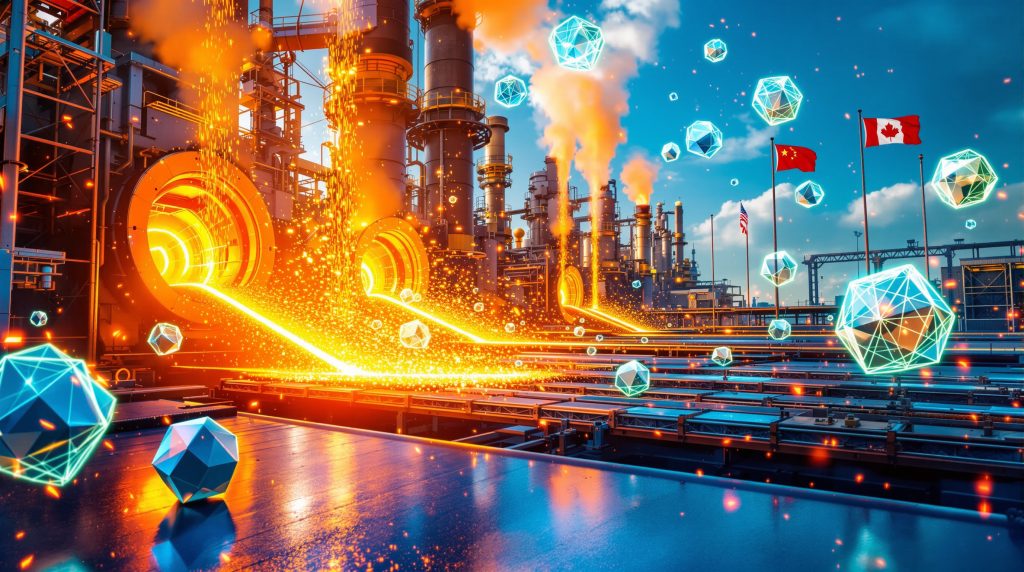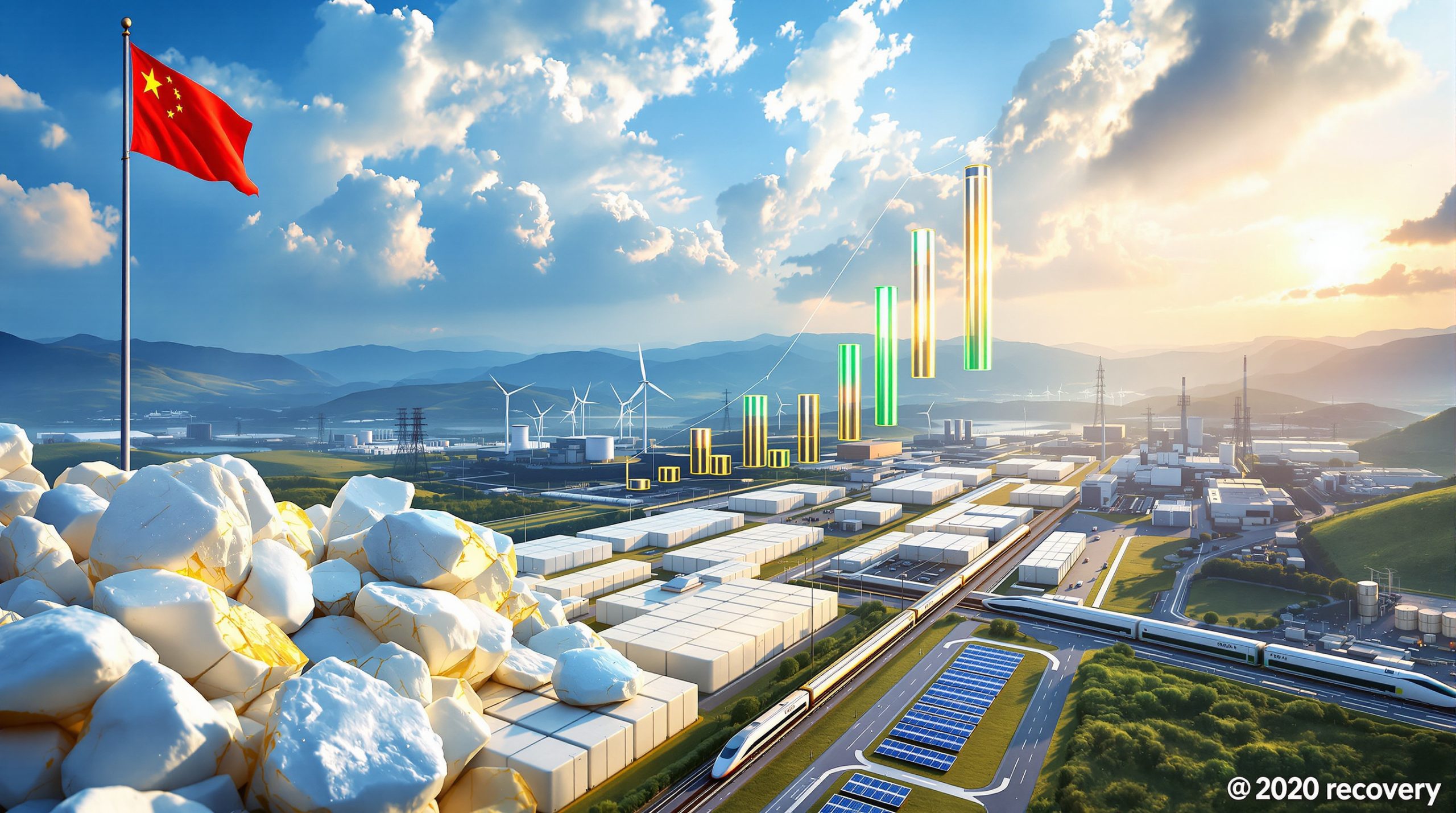What Is Rare-Earth Steel Production and Why Does It Matter?
Rare-earth steel production represents a transformative approach to metallurgy that integrates rare earth elements into conventional steel alloys, creating materials with dramatically enhanced performance characteristics. This innovative field merges traditional steelmaking expertise with advanced materials science to produce alloys that significantly outperform standard steel in critical industrial applications, reflecting broader mining industry trends towards advanced materials development.
The technology has gained strategic importance as nations compete for technological superiority in advanced manufacturing. China's state-owned enterprises have made substantial investments in rare-earth steel capabilities, with integrated mining-to-production facilities positioning them at the forefront of this emerging sector.
Understanding the Fundamentals of REE-Enhanced Metallurgy
The incorporation of rare earth elements into steel matrices fundamentally transforms the material's microstructure and performance profile. Unlike conventional alloying elements, REEs function as metallurgical catalysts that initiate beneficial transformations at the molecular level, resulting in steel variants with enhanced mechanical, thermal, and chemical resistance properties.
These elements, typically added in concentrations of just 0.01-0.1% by weight, create disproportionate improvements in material performance. The precision required for optimal results has driven the development of sophisticated production technologies and quality control systems that support sustainable production approaches.
How Do Rare Earth Elements Transform Steel Properties?
Microstructural Enhancement Mechanisms
When rare earth elements are introduced into molten steel, they initiate several critical metallurgical processes that fundamentally alter the final product's characteristics. These rare earth elements are crucial components in modern industrial applications.
Grain Boundary Purification
- REEs bind with harmful impurities including sulfur and phosphorus
- Formation of stable rare earth compounds effectively removes detrimental elements
- Results in cleaner grain boundaries and significantly improved ductility
Inclusion Modification
- Traditional elongated sulfide inclusions transform into spherical rare earth compounds
- Spherical inclusions dramatically reduce stress concentration points
- Enhanced fatigue resistance and toughness in finished products
Performance Improvements Through REE Addition
| Property Enhancement | Mechanism | Typical Improvement |
|---|---|---|
| Corrosion Resistance | Oxide layer stabilisation | 30-50% improvement |
| Wear Resistance | Microhardness increase | 25-40% enhancement |
| Impact Toughness | Inclusion modification | 20-35% improvement |
| High-Temperature Stability | Grain boundary strengthening | 15-25% better performance |
The magnitude of these improvements has attracted attention from industries requiring materials that can withstand extreme operating conditions, particularly in infrastructure and clean energy applications where critical raw materials play an essential role.
What Are the Primary Applications of Rare-Earth Steel?
Infrastructure and Heavy Industry Applications
Mining Equipment Components
- Excavator buckets and cutting edges requiring exceptional wear resistance
- Crusher linings and wear plates exposed to continuous abrasion
- Conveyor system components operating under heavy loads
Transportation Infrastructure
- High-speed rail components designed for European and Russian standards
- Bridge construction elements requiring enhanced fatigue resistance
- Pipeline systems for hydrogen and carbon dioxide transport applications
Emerging Technology Applications
Clean Energy Systems
- Wind turbine structural components exposed to variable loading
- Solar panel mounting systems requiring long-term durability
- Energy storage infrastructure demanding corrosion resistance
Furthermore, the critical minerals energy transition increasingly relies on advanced materials like rare-earth steel for essential infrastructure development.
The versatility of rare-earth steel makes it particularly valuable in applications where traditional steel fails to meet performance requirements under extreme conditions, driving adoption across multiple industrial sectors.
Which Countries Lead in Rare-Earth Steel Production Technology?
China's Integrated Dominance
China maintains technological leadership through vertically integrated rare earth mining and steel production capabilities. Major state-owned enterprises have developed proprietary techniques for optimised REE addition timing during steel production, precise dosage control for different steel grades, and mass production scaling from laboratory to industrial levels.
The Baogang Group exemplifies this integrated approach, combining ownership of rare earth resources with advanced steel production capabilities. Their strategic focus includes accelerated digital transformation of production facilities, application of industrial AI models for intelligent control systems, and targeting high-end rail applications with Belt-and-Road export ambitions. Moreover, these operations demonstrate how Australia's rare earth reserves factor into global supply chain considerations.
North American Development Initiatives
Canada's Processing Capabilities
- Advanced rare earth metal smelting facilities producing high-purity materials
- Focus on specialised applications requiring precise elemental compositions
- Strategic positioning as alternative supplier to global markets
United States Research Programs
- Government-funded metallurgical research initiatives
- Pipeline steel development for critical energy infrastructure
- University-industry collaboration programs advancing fundamental understanding
What Manufacturing Processes Enable Rare-Earth Steel Production?
Primary Production Methods
Molten Salt Electrolysis
- Used for producing rare earth metal mixtures known as mischmetal
- Cost-effective approach suitable for large-scale production requirements
- Appropriate for applications requiring mixed REE compositions
Calciothermic Reduction
- Produces high-purity individual rare earth metals
- Higher cost but superior quality control capabilities
- Essential for specialised steel applications requiring specific REE compositions
Integration Challenges and Solutions
Timing Optimisation
- REE addition must occur at precisely controlled temperatures
- Coordination with existing steel production schedules and workflows
- Quality control throughout the entire alloying process
Dosage Control Systems
- Automated feeding mechanisms ensuring consistent REE content
- Real-time monitoring of alloy composition and properties
- Waste reduction through precise material usage optimisation
The implementation of intelligent manufacturing systems, including robotics and automated storage solutions, has enhanced production efficiency whilst maintaining quality standards across different steel grades. These advancements represent key aspects of data-driven operations that are transforming industrial manufacturing.
How Does Rare-Earth Steel Production Impact Global Supply Chains?
Strategic Resource Considerations
The production of rare-earth steel production creates new dependencies and opportunities within global manufacturing networks, fundamentally altering traditional supply chain dynamics:
Supply Chain Integration
- Mining operations must coordinate closely with steel producers
- Transportation and storage of reactive rare earth materials require specialised handling
- Quality assurance across multiple processing stages demands sophisticated monitoring
Market Dynamics
- Premium pricing reflects enhanced performance characteristics
- Competition between integrated producers and specialised suppliers intensifies
- Regional supply chain development initiatives respond to geopolitical considerations
Economic Implications
| Factor | Traditional Steel | Rare-Earth Steel |
|---|---|---|
| Raw Material Cost | Lower baseline costs | Higher due to REE premium |
| Processing Complexity | Standard established processes | Advanced technical requirements |
| End-Product Value | Commodity pricing structure | Premium application pricing |
| Market Size | Massive global market | Specialised high-value niches |
The integrated mining-to-advanced-materials model pursued by major producers creates competitive advantages that challenge western supply chain diversification efforts, particularly in downstream industries such as electric vehicle motors, smart rail systems, and hydrogen technology.
What Are the Environmental Considerations?
Sustainable Production Approaches
Resource Efficiency
- Small REE quantities needed typically represent just 0.01-0.1% by weight
- Reduced waste through precise addition techniques and process optimisation
- Extended product lifespan reduces replacement frequency and lifecycle impact
Environmental Impact Mitigation
- Advanced processing technologies reduce harmful byproducts
- Recycling programmes enable rare earth recovery from end-of-life products
- Integration with circular economy principles supports sustainability goals
The development of hydrogen storage materials research, particularly solid-state hydrogen devices for distributed energy applications, demonstrates the potential for rare-earth steel production to support decarbonisation initiatives across transport and industrial sectors.
What Does the Future Hold for Rare-Earth Steel Production?
Technological Advancement Trends
Process Innovation
- Automated quality control systems utilising artificial intelligence
- Real-time composition monitoring with predictive analytics
- Integration of industrial AI models for production optimisation
Application Expansion
- Aerospace component development for extreme environment applications
- Medical device applications requiring biocompatibility and corrosion resistance
- Advanced automotive systems supporting electrification trends
Market Growth Projections
Industry analysis indicates significant expansion potential in rare-earth steel production applications as infrastructure modernisation accelerates globally, clean energy systems demand enhanced materials, and manufacturing processes become more cost-effective through technological advancement.
The strategic focus on export rail certification for European and Russian markets, combined with hydrogen materials research targeting industrial decarbonisation scenarios, suggests substantial growth opportunities in critical infrastructure applications.
The convergence of technological advancement and strategic resource management positions rare-earth steel as a critical material for next-generation industrial applications, particularly in sectors requiring exceptional performance under demanding operating conditions.
Strategic Industry Implications
Geopolitical Considerations
The development of rare-earth steel production capabilities represents more than technological advancement; it embodies strategic competition for industrial leadership. Nations with integrated mining and production capabilities possess significant advantages in supplying high-value materials to critical infrastructure projects.
Western supply chain resilience efforts face intensified competition as integrated producers accelerate their capabilities from raw material extraction through advanced materials manufacturing to strategic exports. This challenge is particularly acute given the extended timeline required for alternative supply chain development, which industry experts estimate could span several years to over a decade.
Market Psychology and Investment Dynamics
Investment Considerations
- Integrated producers with rare earth resources and steel production capabilities hold strategic advantages
- Technical barriers to entry create competitive moats for established players
- Export certification achievements could alter market dynamics in strategic infrastructure sectors
Risk Factors
- Concentration risk in key supplier nations
- Technology transfer and intellectual property considerations
- Regulatory changes affecting trade relationships and market access
Frequently Asked Questions About Rare-Earth Steel Production
What distinguishes rare-earth steel from stainless steel?
Whilst stainless steel relies primarily on chromium for corrosion resistance, rare-earth steel uses REEs to modify the fundamental microstructure, providing comprehensive benefits including enhanced wear resistance, improved mechanical properties, and superior performance under extreme conditions beyond simple corrosion protection.
How do rare earth elements affect steel production costs?
REE costs typically represent 5-15% of total raw material expenses in rare-earth steel production. However, the significant performance improvements often justify premium pricing in specialised applications where traditional steel proves inadequate, creating favourable economics for high-value applications.
Can rare-earth steel maintain its properties through recycling?
Yes, rare-earth steel retains its enhanced properties through conventional recycling processes. Additionally, specialised recovery techniques can extract and reuse the rare earth content for future production cycles, supporting circular economy principles whilst maintaining material performance standards.
What role does artificial intelligence play in rare-earth steel production?
AI systems optimise production parameters including timing of REE additions, temperature control, and quality monitoring. Industrial AI models enable predictive analytics for process optimisation, automated quality control, and intelligent manufacturing systems that improve consistency whilst reducing waste.
Disclaimer: This analysis includes speculative elements regarding market developments and strategic implications. Investment decisions should be based on comprehensive due diligence and professional advice. The rare-earth steel industry involves complex geopolitical and technological factors that may affect market dynamics unpredictably.
Looking for Investment Opportunities in Advanced Materials?
Discovery Alert's proprietary Discovery IQ model delivers real-time alerts on significant mineral discoveries across the ASX, including the rare earth and advanced materials sectors that are driving technological innovation. Subscribers gain immediate market intelligence on emerging opportunities in critical materials production, ensuring they can identify actionable investment positions ahead of the broader market and begin their 30-day free trial today.




